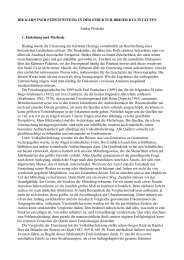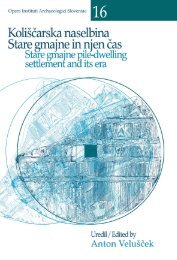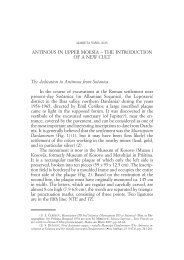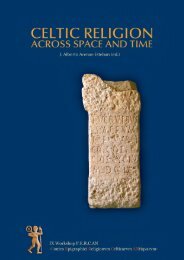The Roman conquest of Dalmatia and Pannonia under Augustus
The Roman conquest of Dalmatia and Pannonia under Augustus
The Roman conquest of Dalmatia and Pannonia under Augustus
Create successful ePaper yourself
Turn your PDF publications into a flip-book with our unique Google optimized e-Paper software.
112 Šašel Kos, <strong>The</strong> <strong>Roman</strong> <strong>conquest</strong> <strong>of</strong> <strong>Dalmatia</strong> <strong>and</strong> <strong>Pannonia</strong> <strong>under</strong> <strong>Augustus</strong><br />
to the Volcaean Marshes, where he was attacked<br />
by both Batos, <strong>and</strong> defeated them. <strong>The</strong> Delmatae<br />
<strong>and</strong> <strong>Pannonia</strong>ns, who were suffering from hunger<br />
<strong>and</strong> diseases, wanted to negotiate for peace the<br />
next year. At this point there is a lacuna in Dio’s<br />
text. Shortly afterwards, Bato the Breucan betrayed<br />
Pinnes <strong>and</strong> was rewarded with comm<strong>and</strong> over the<br />
Breuci. However, the other Bato attacked him in<br />
an ambush <strong>and</strong> had him killed. After the defeat <strong>of</strong><br />
the Breuci by Silvanus, Bato lost all hope <strong>of</strong> being<br />
able to retain <strong>Pannonia</strong>, so he installed guards at<br />
all routes leading to <strong>Dalmatia</strong> <strong>and</strong> pl<strong>under</strong>ed the<br />
country. Soon the other <strong>Pannonia</strong>n peoples also<br />
surrendered. 40<br />
Dio’s account <strong>of</strong> the <strong>conquest</strong> <strong>of</strong> <strong>Dalmatia</strong> in the<br />
last year is much more detailed than that <strong>of</strong> Velleius,<br />
ending with the description <strong>of</strong> Germanicus’<br />
<strong>conquest</strong> <strong>of</strong> Arduba, the fall <strong>of</strong> Andetrium, a naturally<br />
fortifi ed hilltop stronghold not far from Salonae,<br />
<strong>and</strong> the surrender <strong>of</strong> Bato <strong>and</strong> his son Sceuas.<br />
Bato gave a long speech in defence <strong>of</strong> his people,<br />
<strong>and</strong> on being asked why they had started the rebellion,<br />
he replied with the famous words that the<br />
<strong>Roman</strong>s had sent wolves instead <strong>of</strong> shepherd dogs<br />
to the province. 41<br />
Very few small fi nds can be directly related to<br />
Tiberius’ wars in <strong>Pannonia</strong>, mainly because <strong>Roman</strong><br />
or Celtic weapons cannot be defi ned chronologically<br />
in an exact way. A coin hoard was found<br />
between Osijek <strong>and</strong> Valpovo, in the territory <strong>of</strong><br />
Mursa (Osijek), the region <strong>of</strong> the Andizetes, where<br />
an auxiliary camp may have been located after<br />
Tiberius’ <strong>Pannonia</strong>n War. 42 <strong>The</strong> hoard, which<br />
mainly contained coins from the late Republican<br />
period (1st century BC), but included a few coins<br />
minted by <strong>Augustus</strong> between 19 <strong>and</strong> 2 BC, may<br />
have been hidden during the great rebellion. <strong>The</strong>re<br />
are pieces <strong>of</strong> weapons from Cibalae (Vinkovci),<br />
such as a sword, two long narrow-headed spears, a<br />
short spear <strong>and</strong> a conical spear mount that could<br />
have belonged to an indigenous Celtic warrior or<br />
an auxiliary soldier. 43 A Weisenau type helmet <strong>of</strong><br />
the early 1st century AD was found in the Sava<br />
River near the site <strong>of</strong> ancient Marsonia (Slavonski<br />
Brod). Some weapons, particularly helmets, are<br />
known from Siscia (Sisak). 44<br />
40<br />
Cassius Dio 55. 34. 3 – 7.<br />
41<br />
Cassius Dio 56. 11 – 17. 2; Bato’s speech, although fi ctitious,<br />
tells much about <strong>Roman</strong> organisation <strong>of</strong> the province <strong>and</strong><br />
brutality after the <strong>Pannonia</strong>n War.<br />
42<br />
FILIPOVIĆ 2004, 157.<br />
43<br />
DIZDAR / RADMAN-LIVAJA 2004.<br />
44<br />
RADMAN-LIVAJA 2004, 17-18.<br />
Evidence <strong>of</strong> the <strong>Roman</strong> army<br />
in Illyricum<br />
According to current estimation, the following fi ve<br />
legions were stationed in Illyricum at the outbreak<br />
<strong>of</strong> the great rebellion in AD 6: IX Hispana, XIII <strong>and</strong><br />
XIV Gemina, XV Apollinaris <strong>and</strong> XX. Aquileia<br />
retained its great strategic role as an important military,<br />
administrative <strong>and</strong> logistic base during the<br />
<strong>Pannonia</strong>n War <strong>and</strong> the great rebellion; <strong>Roman</strong><br />
troops were temporarily stationed in or around the<br />
city, particularly legio XX, before it was transferred<br />
to Burnum in <strong>Dalmatia</strong> <strong>under</strong> <strong>Augustus</strong>. 45 Emona<br />
was not a camp <strong>of</strong> XV Apollinaris, 46 since at that<br />
time the town was almost certainly a <strong>Roman</strong> colony,<br />
probably founded early in <strong>Augustus</strong>’ reign, if<br />
not soon after Actium. However, legions, or parts <strong>of</strong><br />
them, must have been temporarily stationed in <strong>and</strong><br />
around Emona as well; it, too, must have had a signifi<br />
cant logistic role. 47 IX Hispana was probably<br />
stationed in Siscia, where more than two legions<br />
had already been left by Octavian in 34 BC, <strong>and</strong><br />
where the summer camp <strong>of</strong> the three <strong>Pannonia</strong>n<br />
legions in AD 14 (the year <strong>of</strong> their revolt after the<br />
death <strong>of</strong> <strong>Augustus</strong>) was most probably located. 48<br />
<strong>The</strong> Emona Basin was situated at the far border<br />
with the <strong>Pannonia</strong>n part <strong>of</strong> Illyricum, <strong>and</strong> had to<br />
be protected. Archaeological evidence indicates<br />
that Nauportus was fortifi ed in the Augustan age<br />
(Fig. 4). 49 Recent excavations <strong>and</strong> new fi nds also<br />
confi rm the logistic role <strong>of</strong> Emona in Tiberius’ <strong>Pannonia</strong>n<br />
War. 50 A camp from this period was located<br />
close to the Ljubljanica River, 51 which in addition<br />
to connecting Nauportus <strong>and</strong> Emona, could – since<br />
it fl ows into the Sava – easily have been used to<br />
convey cargo <strong>and</strong> even troops directly from Nauportus<br />
to Segestica/Siscia. 52 Many important fi nds<br />
were discovered in the Ljubljanica, such as a medallion<br />
with a portrait <strong>of</strong> <strong>Augustus</strong> that could have<br />
been worn by a <strong>Roman</strong> soldier fi ghting in the <strong>Pannonia</strong>n<br />
War. 53 Further camps have recently been<br />
45<br />
WILKES 1969, 92-93.<br />
46<br />
According to the epigraphic, numismatic <strong>and</strong> other archaeological<br />
evidence, Emona was most probably never a legionary<br />
fortress on any permanent basis: ŠAŠEL 1968, 561 ff. (1992, 571<br />
ff.); ŠAŠEL KOS 1995; GASPARI 2010, 113 ff.<br />
47<br />
GASPARI 2010, passim, particularly 113 ff. <strong>and</strong> 141 ff.<br />
48<br />
ŠAŠEL 1974, 732-734 (1992, 615-616).<br />
49 MUŠIČ / HORVAT 2007.<br />
50 MIŠKEC 2009.<br />
51<br />
HVALEC et al. 2009.<br />
52<br />
ISTENIČ 2009.<br />
53<br />
ISTENIČ 2003; ISTENIČ 2009a.










